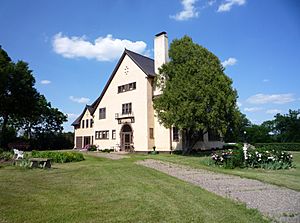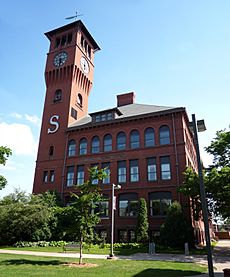Menomonie, Wisconsin facts for kids
Quick facts for kids
Menomonie, Wisconsin
|
|
|---|---|
|
City
|
|
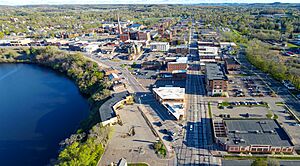
Downtown Menomonie and UW-Stout
|
|
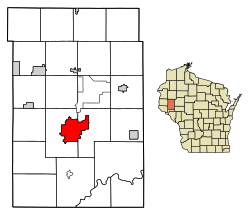
Location of Menomonie
in Dunn County, Wisconsin |
|
| Country | United States |
| State | Wisconsin |
| County | Dunn |
| Founded by | William Wilson |
| Area | |
| • Total | 15.44 sq mi (39.98 km2) |
| • Land | 13.70 sq mi (35.47 km2) |
| • Water | 1.74 sq mi (4.51 km2) |
| Population
(2020)
|
|
| • Total | 16,843 |
| • Estimate
(2021)
|
16,794 |
| • Density | 1,229.9/sq mi (474.9/km2) |
| Time zone | UTC−6 (Central (CST)) |
| • Summer (DST) | UTC−5 (CDT) |
| Zip Code |
54751
|
| Area code(s) | 715 & 534 |
| FIPS code | 55-51025 |
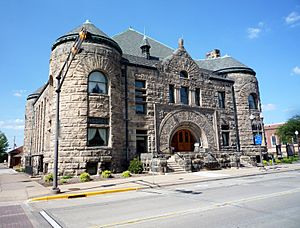
Menomonie (/məˈnɒməni/) is a city in western Wisconsin, USA. It is the main city in Dunn County. The city had 16,843 people living there in 2020.
The city is named after the Menominee people, who first lived in this area. Menomonie is the center of a larger area called the Menomonie Micropolitan Statistical Area. This area includes all of Dunn County. The city center is located at the south end of Lake Menomin. This lake is a reservoir on the Red Cedar River.
Contents
History of Menomonie
Early People and Settlers
The first people known to live in this area were from the Hopewell Culture. They lived here between 100 and 400 CE. You can still see mounds they built in Wakanda Park. Later, the Santee Dakota and Ojibwe tribes lived and sometimes fought here.
In 1788, a French-Canadian fur trader named Jean Baptiste Perrault set up a trading post. This was very close to where Menomonie is today.
The Lumber Industry Boom
In the 1800s, the lumber industry brought many people to Menomonie. The first sawmill was built in 1822. This mill helped start the first permanent settlement in the area.
In 1846, William Wilson and John Holly Knapp bought the mill. They called it Black & Knapp Mill. William Wilson and his family moved to the area. He later built the Wilson Place Museum in 1859. Wilson helped found the city of Menomonie and became its first mayor in 1882. He also served as a Wisconsin State Senator.
Knapp, Stout & Co.
In 1853, Captain Andrew Tainter and Henry L. Stout joined Wilson and Knapp. They formed a company called Knapp, Stout & Co.. This company became the biggest lumber company in the world by 1873. It had 1,200 employees and owned a huge amount of pine forest.
Menomonie officially became a city in 1882.
Education and New Beginnings
The Mabel Tainter Memorial Building was built in 1890. It was a gift from Captain Andrew Tainter to honor his daughter, Mabel. Today, it is known as the Mabel Tainter Center for the Arts.
In 1891, Wisconsin State Senator James Huff Stout started a manual training school. This school grew and became the University of Wisconsin–Stout. It is still a very important part of Menomonie today.
In 1901, the big lumber company, Knapp, Stout & Co., closed its operations. New businesses came to Menomonie. The world's first outboard motor factory opened here. In 1902, Menomonie also started the nation's first agricultural high school.
Geography and Climate
Where is Menomonie?
Menomonie is located in western Wisconsin. It is found at coordinates 44°52′45″N 91°55′5″W / 44.87917°N 91.91806°W.
The city covers about 15.47 square miles (39.98 square kilometers). Most of this is land, but about 1.78 square miles (4.51 square kilometers) is water.
Major roads like Interstate 94, State Highway 25, and U.S. Highway 12 pass through Menomonie.
Menomonie Weather
Menomonie has a climate with warm summers and cold, snowy winters.
| Climate data for Menomonie, Wisconsin, 1991–2020 normals, extremes 1957–present | |||||||||||||
|---|---|---|---|---|---|---|---|---|---|---|---|---|---|
| Month | Jan | Feb | Mar | Apr | May | Jun | Jul | Aug | Sep | Oct | Nov | Dec | Year |
| Record high °F (°C) | 55 (13) |
60 (16) |
82 (28) |
90 (32) |
96 (36) |
98 (37) |
100 (38) |
101 (38) |
96 (36) |
90 (32) |
76 (24) |
64 (18) |
101 (38) |
| Mean maximum °F (°C) | 42.7 (5.9) |
48.4 (9.1) |
62.6 (17.0) |
77.8 (25.4) |
85.4 (29.7) |
89.9 (32.2) |
91.0 (32.8) |
90.1 (32.3) |
86.3 (30.2) |
79.3 (26.3) |
62.3 (16.8) |
47.1 (8.4) |
92.9 (33.8) |
| Mean daily maximum °F (°C) | 24.0 (−4.4) |
29.4 (−1.4) |
41.9 (5.5) |
56.4 (13.6) |
68.2 (20.1) |
77.9 (25.5) |
82.0 (27.8) |
79.9 (26.6) |
72.2 (22.3) |
58.9 (14.9) |
42.7 (5.9) |
29.2 (−1.6) |
55.2 (12.9) |
| Daily mean °F (°C) | 14.3 (−9.8) |
18.3 (−7.6) |
30.6 (−0.8) |
44.3 (6.8) |
56.3 (13.5) |
66.3 (19.1) |
70.6 (21.4) |
68.3 (20.2) |
60.2 (15.7) |
47.5 (8.6) |
33.1 (0.6) |
20.6 (−6.3) |
44.2 (6.8) |
| Mean daily minimum °F (°C) | 4.5 (−15.3) |
7.3 (−13.7) |
19.3 (−7.1) |
32.3 (0.2) |
44.4 (6.9) |
54.8 (12.7) |
59.2 (15.1) |
56.7 (13.7) |
48.2 (9.0) |
36.0 (2.2) |
23.6 (−4.7) |
12.0 (−11.1) |
33.2 (0.7) |
| Mean minimum °F (°C) | −17.8 (−27.7) |
−13.5 (−25.3) |
−1.8 (−18.8) |
18.5 (−7.5) |
30.4 (−0.9) |
41.2 (5.1) |
48.5 (9.2) |
46.4 (8.0) |
33.8 (1.0) |
22.6 (−5.2) |
7.8 (−13.4) |
−9.9 (−23.3) |
−20.2 (−29.0) |
| Record low °F (°C) | −39 (−39) |
−40 (−40) |
−34 (−37) |
4 (−16) |
20 (−7) |
30 (−1) |
41 (5) |
37 (3) |
25 (−4) |
12 (−11) |
−13 (−25) |
−36 (−38) |
−40 (−40) |
| Average precipitation inches (mm) | 0.94 (24) |
1.08 (27) |
1.97 (50) |
2.96 (75) |
4.53 (115) |
5.14 (131) |
4.02 (102) |
4.02 (102) |
3.63 (92) |
2.74 (70) |
1.82 (46) |
1.34 (34) |
34.19 (868) |
| Average snowfall inches (cm) | 9.7 (25) |
11.0 (28) |
7.3 (19) |
2.4 (6.1) |
0.0 (0.0) |
0.0 (0.0) |
0.0 (0.0) |
0.0 (0.0) |
0.0 (0.0) |
0.2 (0.51) |
3.5 (8.9) |
6.3 (16) |
40.4 (103.51) |
| Average precipitation days (≥ 0.01 in) | 8.0 | 6.3 | 8.0 | 10.5 | 12.9 | 12.6 | 10.9 | 10.4 | 10.5 | 10.3 | 7.6 | 8.5 | 116.5 |
| Average snowy days (≥ 0.1 in) | 5.4 | 4.4 | 3.0 | 1.0 | 0.1 | 0.0 | 0.0 | 0.0 | 0.0 | 0.1 | 1.8 | 5.4 | 21.2 |
| Source 1: NOAA | |||||||||||||
| Source 2: National Weather Service | |||||||||||||
People of Menomonie
| Historical population | |||
|---|---|---|---|
| Census | Pop. | %± | |
| 1860 | 970 | — | |
| 1870 | 2,210 | 127.8% | |
| 1880 | 4,177 | 89.0% | |
| 1890 | 5,491 | 31.5% | |
| 1900 | 5,655 | 3.0% | |
| 1910 | 5,036 | −10.9% | |
| 1920 | 5,104 | 1.4% | |
| 1930 | 5,595 | 9.6% | |
| 1940 | 6,582 | 17.6% | |
| 1950 | 8,245 | 25.3% | |
| 1960 | 8,624 | 4.6% | |
| 1970 | 11,112 | 28.8% | |
| 1980 | 12,769 | 14.9% | |
| 1990 | 13,547 | 6.1% | |
| 2000 | 14,937 | 10.3% | |
| 2010 | 16,264 | 8.9% | |
| 2020 | 16,843 | 3.6% | |
| 2021 (est.) | 16,794 | 3.3% | |
| U.S. Decennial Census | |||
Population in 2020
In 2020, Menomonie had 16,843 people. The city had about 1,230 people per square mile. Most residents (88.1%) were White. Other groups included Asian (4.4%), Black (1.7%), and Native American (0.5%). About 2.8% of the population was Hispanic or Latino.
Population in 2010
In 2010, there were 16,264 people living in Menomonie. The population density was about 1,188 people per square mile. Most people (91.9%) were White. Other groups included Asian (4.2%), Black (0.8%), and Native American (0.5%). About 1.7% of the population was Hispanic or Latino.
The average age in the city was 23.4 years. Many people between 18 and 24 years old were students at the University of Wisconsin-Stout.
Getting Around Menomonie
| Headquarters | 640 Stokke Parkway, Menomonie, Wisconsin |
|---|---|
| Locale | Menomonie, Wisconsin |
| Service type | Bus service, paratransit |
| Routes | 2 |
| Fleet | 9 |
| Annual ridership | 94,599 (2022) |
Dunn County Transit System
Menomonie has a public bus system called Dunn County Transit. It is run by Dunn County.
Bus Routes
The bus system has two main routes:
- Community Route: This bus serves the whole city of Menomonie. It runs Monday to Friday from 7:37 AM to 4:09 PM, and on Saturdays from 8:53 AM to 12:09 PM.
- Stout Route: This bus mainly serves UW-Stout university. It runs Monday to Friday from 7:17 AM to 9:09 PM. Anyone can ride this route, not just students.
Bus Ridership
Many people use the bus system. In 2022, over 94,000 people rode the Dunn County Transit buses.
Menomonie also has a local airport, the Menomonie Municipal Airport (KLUM).
Education in Menomonie
Schools in Menomonie are part of the Menomonie Area School District.
The city has:
- One public high school: Menomonie High School
- One public middle school: Menomonie Middle School
- Five public elementary schools: River Heights, Wakanda, Oaklawn, Downsville, and Knapp Elementary.
St. Paul's Lutheran School is a private Christian school for Pre-K through 8th grade.
Menomonie is also home to the University of Wisconsin–Stout and a campus of Chippewa Valley Technical College.
Local Media
Menomonie has a local newspaper called The Dunn County News. In the past, there were other newspapers like The Menomonie Times and The Menomonie Badger.
City Honors
In 2012, Smithsonian magazine named Menomonie one of "The 20 Best Small Towns in America." It was ranked #15 on the list!
Famous People from Menomonie
- Stewart J. Bailey, a Wisconsin politician
- Bill Bakke, an Olympic ski jumper
- Alvin J. Baldus, a U.S. Representative
- Wilfred Duford, an NFL football player
- Rockwell J. Flint, a Wisconsin politician and newspaper editor
- Vern Fuller, an MLB baseball player
- Neil Gaiman, a famous writer and screenwriter who lives near Menomonie
- Tim Harmston, a stand-up comedian
- Lorenzo D. Harvey, an educator
- Ethan Iverson, a jazz pianist
- Warren S. Johnson, who founded Johnson Controls
- Ellen Kort, Wisconsin's first Poet Laureate
- Reynold Kraft, an NFL football player
- Tim Krumrie, a Pro Bowl nose tackle for the Cincinnati Bengals
- Robert Macauley, a Wisconsin politician and judge
- Harry Miller, a famous designer of racing cars
- Tom Neumann, a professional football player
- Marvin Panch, a stock car racing driver who won the 1961 Daytona 500
- Sewell A. Peterson, a politician
- Charles Sanna, the inventor of Swiss Miss instant hot chocolate
- Richard Shoemaker, a Wisconsin politician
- Nate Stanley, an NFL football player
- James Huff Stout, a politician and businessman
- Tom Wiedenbauer, a Major League Baseball player and coach
- Aaron Yonda, a comedy video producer
Fun Places to Visit
- The Mabel Tainter Theater
- Hoffman Hills State Recreation Area
- Red Cedar State Trail
Sister Cities
Menomonie has two sister city relationships with cities in other countries:
See also
 In Spanish: Menomonie (Wisconsin) para niños
In Spanish: Menomonie (Wisconsin) para niños





